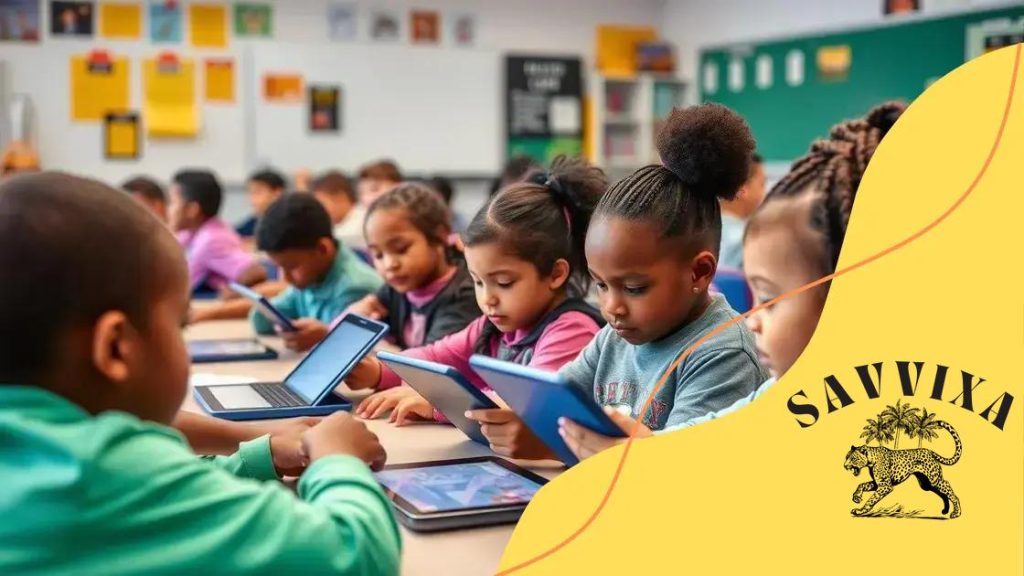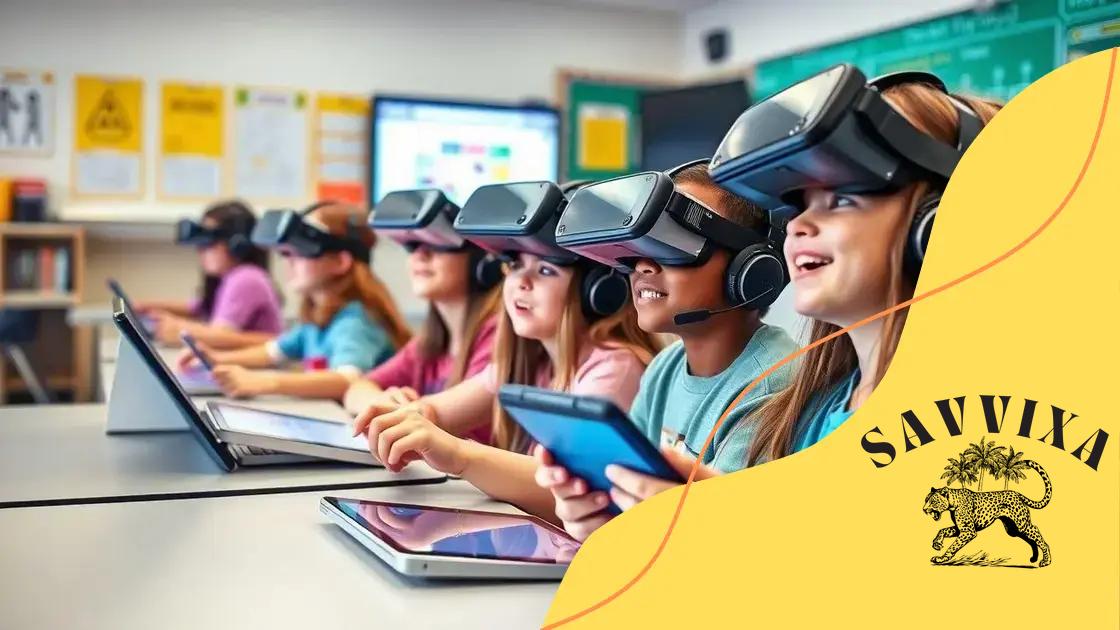Technology bridging educational gaps: a new frontier

Technology bridging educational gaps uses tools like AI, VR, and online platforms to create equitable learning opportunities, ensuring all students can thrive through personalized and interactive educational experiences.
Technology bridging educational gaps offers a unique opportunity to redefine learning experiences for everyone. Have you ever considered how tech can empower students of all backgrounds? In this article, we’ll dive into its impact and potential.
Understanding the digital divide
Understanding the digital divide is essential to grasp how technology impacts education today. This gap exists between those who have easy access to digital technology and those who do not, influencing learning opportunities.
The digital divide can affect students in various ways. To comprehend its implications, we can explore it through multiple angles.
Causes of the Digital Divide
Several factors contribute to the digital divide. These include:
1. Socioeconomic status
2. Geographical location
3. Access to internet services
Students from low-income families often lack the necessary technology to succeed in school. This challenge makes it harder for them to compete with peers who have better access.
Impact on Education
The digital divide affects students’ education significantly. For instance, those without reliable internet may struggle to complete assignments, limiting their learning potential. Furthermore, teachers may face challenges in delivering lessons effectively when not all students have access to technology.
- Educational resources become less accessible.
- Remote learning opportunities can be hindered.
- Collaboration among students may decrease.
Addressing the digital divide is vital for fostering equitable education. Technology should be an ally, not a barrier. As we explore ways to enhance access, we can create a more inclusive environment where every student can thrive.
Innovative tools reducing educational disparities
Innovative tools play a crucial role in reducing educational disparities. These technologies help bridge the gap between students with varying access to resources. By creating engaging learning experiences, they empower all learners.
Many schools have begun to implement digital platforms that make education more accessible. These platforms include online learning resources, virtual classrooms, and interactive programs.
Types of Innovative Tools
Some tools specifically designed to support education include:
1. Learning Management Systems (LMS)
2. Educational apps and software
3. Online tutoring services
These tools provide students with the flexibility to learn at their own pace, catering to individual needs. They also allow teachers to monitor progress and adjust instruction based on real-time data.
Benefits of Using Innovative Tools
The benefits are clear. First, they improve engagement by making learning interactive. Second, they provide access to a wealth of resources that can enhance understanding. Lastly, they offer opportunities for collaboration, as students can work together online.
- Promotes personalized learning experiences.
- Encourages creativity and critical thinking.
- Allows for instant feedback and support.
As schools continue to adopt these technologies, the potential for reducing educational disparities grows. However, it is essential to ensure that every student has equal access to these innovative tools to maximize their benefits.
Real-life examples of technology in education

Real-life examples of technology in education showcase how innovative tools transform learning experiences. Schools globally are adopting these technologies to engage students and enhance educational outcomes.
One notable example is the use of virtual reality (VR) in classrooms. VR allows students to explore historical sites or complex scientific concepts without leaving their desks. This immersive experience enriches their understanding and makes learning more enjoyable.
Online Learning Platforms
Online learning platforms have gained immense popularity. Programs like Khan Academy and Coursera provide access to a wide range of courses. These platforms allow students to learn at their own pace and revisit challenging topics as needed.
- Flexible learning schedules.
- Diverse course offerings.
- Opportunity for self-paced learning.
Furthermore, many schools leverage learning management systems (LMS) to streamline course materials and assignments. Tools like Google Classroom help teachers manage classes efficiently. They can share resources, provide feedback, and communicate with students easily.
Interactive Classroom Technology
Interactive whiteboards and tablets have also transformed traditional classrooms. They promote active participation and collaboration. For example, students can work together on projects using their devices, fostering teamwork and creativity.
In addition, educators use gamification to make lessons more engaging. By incorporating game elements into learning, teachers motivate students to participate actively. Examples include quiz platforms that turn assessments into friendly competitions.
These real-life examples illustrate the potential of technology in education. They demonstrate how effective tools can support learning and help close the existing gaps in education.
Challenges in adopting educational technology
Adopting educational technology comes with several challenges that schools and educators must navigate. While technology has the potential to enhance learning, some obstacles can hinder its effective use.
One major challenge is the digital divide. Many students lack access to the necessary devices or reliable internet. This gap can lead to disparities in learning opportunities, leaving some students at a disadvantage.
Resistance to Change
Another challenge educators face is resistance to change. Teachers who are used to traditional teaching methods may be hesitant to embrace new tools. This reluctance can slow down the integration of technology in the classroom.
- Comfort with existing strategies.
- Fear of the unknown.
- Lack of training on new tools.
Furthermore, technical issues can also pose a challenge. Frequent software glitches or connectivity problems can disrupt lessons. When technology fails, it may frustrate both teachers and students, leading to a lack of trust in digital tools.
Limited Funding
Limited funding is another obstacle in adopting educational technology. Schools often have tight budgets, making it hard to invest in new tools and infrastructure. Without proper resources, implementing technological solutions may be ineffective or impossible.
Finally, teacher training is critical yet often overlooked. Educators need ongoing professional development to stay updated on the latest technology and best practices. Investing in training can help ease the transition and ensure all staff feel confident using new tools.
Addressing these challenges is essential for successfully integrating technology into education. It requires a collaborative effort among schools, educators, and communities to create an environment where technology can thrive and benefit all learners.
Future trends in educational technology
The future of educational technology is exciting, with trends that promise to reshape how students learn and interact in classrooms. As technology continues to evolve, it offers innovative solutions to enhance education.
One significant trend is the rise of artificial intelligence (AI) in education. AI can provide personalized learning experiences by adapting to the needs of each student. It can analyze a student’s strengths and weaknesses and offer tailored resources to help them succeed.
Growth of Augmented and Virtual Reality
Another trend to look out for is the growth of augmented reality (AR) and virtual reality (VR)
In addition, the integration of gamification in learning is becoming more popular. By incorporating game-like elements into lessons, educators can motivate students and make learning fun. This trend encourages collaboration and competition among peers, leading to a more enriching experience. As technology use in education grows, so does the importance of data privacy and security. Educators and institutions must ensure that students’ information is protected. Schools are increasingly focusing on policies and tools that keep personal data secure. Lastly, the demand for flexible learning options will continue to rise. Online learning and hybrid models have shown their effectiveness, allowing students to learn from anywhere at their own pace. This flexibility empowers learners to balance their studies with other commitments. By staying informed about these trends, educators can better prepare for the future. Embracing these changes will create a more inclusive and effective learning environment for all students. The digital divide refers to the gap between students who have easy access to technology and those who do not, impacting their learning opportunities. AI can provide personalized learning experiences by adapting to individual student needs, helping them succeed at their own pace. Virtual reality makes learning immersive and interactive, allowing students to explore complex topics and environments they wouldn’t normally access. Data privacy is crucial to protect students’ personal information and ensure their safety while using technological tools in learning environments.
Increased Focus on Data Privacy and Security
FAQ – Frequently Asked Questions about Educational Technology
What is the digital divide in education?
How can AI be used in education?
What are some benefits of using virtual reality in the classroom?
Why is data privacy important in educational technology?